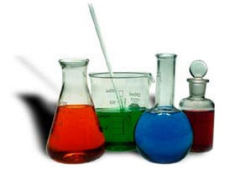|



|
| Goal
I. Use SI units to indicate the accuracy and precision of measurements. |
Objectives: To meet the requirements of Goal
I, you must be able to:
-
identify the
SI
base units and correct abbreviations for the physical quantities
given in Table 1.2, p. 17;
-
know the
SI prefixes and their related association factors listed in
BOLD
in Table 1.3, p. 18;
-
convert
from one SI unit to another;
-
distinguish between
accuracy and precision;
-
relate the number
of significant digits used in recording a measured quantity;
-
understand the rules
for:
-
determining the number of significant figures in a reported
measurement
-
for applying significant figures
to the results of the mathematical operations of addition-subtraction and
multiplication-division. [Top]
| Goal II. Apply the rules
of measurement to the properties of mass, volume, density, and temperature. |
Objectives: To meet the requirements of Goal
II, you must be able to:
-
distinguish between:
-
mass, volume and density,
-
extensive and intensive properties,
-
heat and temperature;
-
calculate mass,
volume or density given two of the three quantities;
- convert
temperatures using Celsius, and Kelvin scales.[Top]
| Goal III. Understand the
relationship between the mass of a sample of matter and the number of its
constituent particles. |
Objectives: To meet the requirements of Goal
III, you must be able to:
-
explain and correctly
use the terms: neutron, isotope, mass number, nuclide,
universal atomic mass unit, radioactive nuclide, hydrate;
-
determine the number
of protons, neutrons and electrons in atoms and given the specific nuclide
notation and vice versa;
- calculate the
average atomic mass for a naturally occurring element
from isotope percentage and isotope mass;
-
calculate the formula
mass (FM) [also called molecular mass (MM)] of a compound, given a molecular
or ionic formula for that compound, and using atomic masses from the periodic
table;
-
define mole,
Avogadro's number and know
the
value to 4 significant figures of Avogadro's number;
-
convert between
mass in grams, moles and numbers of atoms. [Top]
|
Unit 2 Assignments
|
| Read: |
Text
Chapter 1.3, 1.4, 1.5, 1.6, pp. 8-34
Text Chapter 2.5,
pp. 53-58
Text Chapter 3.1,
pp. 89-95 |
| Video
Programs: |
- Types of Chemical
Equations
- Measurements
and Significant Figures
- Mole Concept
|
| Textbook
Assignments: |
Read
and Understand all "Sample Problems," "Follow Up
Problems" and the blue-colored problems at the end of
the chapters.
The
answers for the Follow Up Problems are at the end
of the chapter; the answers for the blue-colored problems
are in Appendix C.The answers for each of these are
in Appendix C.
|
| ChemSkill
Builder Assignments: |
Mandatory
assignments to be submitted for grade
Chapter
1.6 Temperature
Chapter 2.1 Scientific notation, 2.2 Significant figures,
2.3 Measurements & interpolation, 2.4 Metric prefixes,
2.5 Dimensional Analysis, 2.6 Density & volume
Chapter 4.1 Mole
|
| f |
Do
Worksheet
2 & Worksheet
3 Submit them via mail to ELI |
| Take
Exam 1 |
Exam
1 covers Units 1 and 2. You will be given a Periodic
Table (without names of elements) for this exam.
You may use a 3" x 5" hand-written study card for Exams 1, 2, 3, 4, and 5. (NOT TO BE USED FOR THE NOMENCLATURE TEST.) You must hand-write the information you would like to have on your card yourself -- no technology miracles allowed. Formulas, constants, definitions, concepts, solubility tables, etc., may be on the study card. NO SAMPLE PROBLEMS are allowed to be on the card. You may write on both sides of the study card. The card must be submitted with your exam. Any abuse of this privilege will result in a failing grade for the course. |
[Top]
  
|
